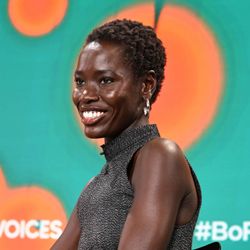Share

The Business of Fashion Podcast
How Zac Posen is Reenergising Gap Inc.
Zac Posen burst onto the fashion scene in the early 2000s, gaining acclaim for his glamorous designs and dressing Hollywood's elite. After nearly two decades, Posen closed his label in 2019, finding himself at a crossroads that eventually led to a meeting with Richard Dickson, the new CEO of Gap Inc., and the chance to join the company as creative director. Now, he's on a mission to bring cultural relevance and excitement back to brands like Gap, Old Navy, Banana Republic, and Athleta.
“Within five minutes [of meeting Dickson], I knew that there was something very special. It was a cosmic moment where there was like a magic connection, where I saw that I had met my dreamer,” Posen says.
This week on The BoF Podcast, BoF founder and editor-in-chief Imran Amed sits down with Posen to explore his journey of redefining success, his transformative role at Gap Inc., and his vision for the future of fashion.
Key Insights
- Closing his eponymous fashion label forced Posen to reevaluate how he defined success, shifting his focus from external achievements to personal fulfilment and creative expression. "Success for me is about being able to inspire a larger public, to be able to work within my own creativity and to use that and what I represent to help a larger public be in touch with their own creativity” he says. “To me, creativity is as essential as sleeping and eating and everything else wonderful in life."
- Posen found new creative inspiration through returning to his roots of draping and garment creation. “I was back on a mannequin … and just expressing and sculpting in space, it felt exciting,” he shares, describing the joy of reconnecting with hands-on creative work in his father’s studio, the same place where his journey in fashion began. “It felt like a full circle moment.”
- As creative director of Gap. Inc, Posen is working to modernise brands like Old Navy and Gap by emphasising storytelling, redefining brand identities, and making subtle evolutions that reignite consumer interest. "Building a brand is about being part of the cultural conversation and moving at the speed of culture and actually being able to help move culture forward,” he says.
- Posen advises young designers to be patient, embrace the balance between art and commerce, and appreciate the opportunity to inspire others. “Creativity is a lifelong pursuit … You can't foresee the path and where it will take you,” he says. “If you are able to work in this industry, to be able to work in a creative field and … understand that fabulous, amazing, magical pendulum that has to be in balance, you are so lucky and so fortunate.”
Additional Resources:
- The Gap Comeback That’s Actually Working | BoF
- Do Mass Brands Need Creative Directors? | BoF
- Creating Cultural Moments in the Age of Algorithms | BoF
More episodes
View all episodes

The Themes That Will Define the 2026 Fashion Agenda
25:24|BoF and McKinsey’s annual State of Fashion report finds the industry entering 2026 with caution: 46 percent of executives expect conditions to worsen, citing geopolitics, macro volatility and the risk of shoppers pulling back. Yet there is also a pulse of optimism around AI-driven efficiency, luxury’s creative recalibration and fresh consumer interest in categories from smart glasses to fine jewellery.Tariffs remain the dominant near-term swing factor. Brands mitigated pain in 2025 by pulling forward inventory, but as that cushion runs out, the full impact shows up in 2026 in costs and pricing. More broadly, luxury’s era of price-led growth has run its course; as BoF correspondent Marc Bain puts it, if you ask customers to pay more, you have to “actually offer the value for the price.”Key Insights:The mood has shifted from “uncertain” in 2025 to “challenging” in 2026. Companies feel better equipped but are bracing for a tougher year. “Uncertainty was ‘we don’t know what’s going to happen’. The challenge is, we know what is going to happen and it’s going to be tough,” says Bain.Tariffs will continue to bite in 2026, and price hikes will be part of the playbook. Brands used a mix of mitigation tactics in 2025, but many still expect to pass on costs. “The strategy that the highest number of executives said was their way of mitigating the tariff impact was raising prices,” Bain notes. “To some degree, there's just no way around that. You can do it strategically, but at some point you're probably going to have to raise prices.”Jewellery is the consumer bright spot for the year ahead, as the category has steadily outperformed thanks to steadier, more gradual price rises, exciting design and a strong perception of value retention. “It’s hard luxury… you can wear it a lot and it can still be in good shape,” Bain says, adding that more women self-purchasing are reinforcing demand, with maximal accessories over minimal wardrobes adding another tailwind. He adds, “It sounds almost silly in 2026, but a big shift has been that more women are actually buying jewellery for themselves.According to Bain, 2026 is the year AI gets embedded into the fashion ecosystem. Expect a ‘two steps forward, one step back’ year where efficiency wins drive adoption even as mishaps make headlines. “Companies don’t feel like they can sit out AI,” Bain says. “It’s not like everyone by the end of next year is going to be using ChatGPT instead of Google, but the expectation is it'll be a significantly higher number than [2025]. And at a certain point, even if it's 5 percent of shoppers … it's still enough that you as a business have to start accounting for it. Additional Resources:The 10 Themes That Will Define the Fashion Agenda in the Year Ahead | BoF The Perfect Package: What It Takes to Be a Fashion Leader in 2026 | BoFThe Top Trends That Will Define Beauty in 2026 | BoF
DJ Black Coffee on Breaking Barriers and Building Global Credibility
26:50|A DJ from South Africa who survived a life-altering accident on the night of Nelson Mandela’s release, Black Coffee has gone on to headline the world’s biggest stages. At BoF VOICES 2025, he reflected on building global credibility — and on reshaping how the African continent is seen. “If you Google a picture of Africa … it’s not going to be the most positive picture you see,” he says. “To be a DJ in South Africa, it’s one of the toughest things because almost every DJ is amazing. To be a DJ on the global level is way tougher because I come from a continent that was — or maybe still is — not seen as how it truly is.” In conversation with BoF founder and CEO Imran Amed, Black Coffee talk about rejecting pigeonholes, earning trust on a global level, and opening doors for the next generation. Key Insights: To compete beyond South Africa, Black Coffee says he had to work on the music and the optics of Africa on the global stage. The solution was rigorous self-presentation: “Whilst I was growing as a brand, fashion played a very big role for me. I was very conscious of how I presented myself,” he says. “The bigger the brand, the more intentional I was. It took a lot of work.” That mix of sound, style and discipline underpinned his transition from local star to international headliner.The night Nelson Mandela walked free changed his life forever. Struck in a crowd by a taxi and left with a nerve damage injury, he channelled his recovery into music and silence into resolve. “[Mandela’s] release from jail marked the beginning of a different journey for me, the first day of the beginning of Black Coffee,” he says. Speaking publicly about the accident only years later, he refused pity and insisted on being seen first as a musician with “passion and love for music.”Black Coffee is blunt about structural bias. “At the Grammys, instead of giving Tyla a number-one pop award, they will create a new genre or category where it’s best African,” he says. Reflecting on his own experience at the BET Awards, he recounts: “We were all given our awards on Friday and we were not invited on the main show on Saturday.”His advice to young creatives is simple and radical: “Just listen to your voice. That voice is the voice that will make you the greatest.” The mission is not only visibility but parity – moving African talent from a side-room to the main stage.Additional Resources: BoF VOICES 2025: Creativity as a Vehicle for Connection Black Coffee| BoF 500
Awar Odhiang on Joy, Inclusion and Her Viral Chanel Moment
26:25|Born to South Sudanese parents and raised in Canada after arriving as refugees in 2002, Awar Odhiang grew up far from fashion’s orbit. She was studying health sciences and planning a career in medicine, when she was scouted at her first job. Her career began locally in Calgary, then accelerated fast after she launched internationally in 2019 — with early runway breaks, a packed show schedule and global campaigns. Then came the moment that stopped the industry when she closed the most-watched debut of the season at Matthieu Blazy’s Chanel show in October.“The moment that really allowed me to fill that space in that way was the freedom that I was given, truly,” she says. Backstage, Matthieu Blazy, Chanel’s new creative director encouraged her to own the moment. “I just felt so free, so confident, so beautiful. You can tell Matthieu loves women just by his designs.”In this conversation from BoF VOICES 2025, I speak with Awar about the gap between being celebrated publicly and understood privately, why inclusion has to extend to behind the camera and the boundaries she is setting to protect her sense of joy in an industry that rarely slows down.Key Insights:Odhiang recounts meeting agent Kelly Streit whilst working her first job in retail and her scouting story captures a pivotal shift in self-belief. “That was a moment that now I can look back at and realise that he believed in me before I even believed in myself,” she says. From folding sweaters at Old Navy to international runways by 2019, she frames the leap as an intentional decision to embrace an unexpected opportunity.As a high profile dark skinned model, her growing visibility hasn’t eliminated her feelings of isolation. “One of the darker sides of modelling I would say is really the [lack of] inclusion … the fact that we’re still talking about this today really shows how big of a problem that is.” She defines inclusivity as being allowed to be at ease rather than just token representation: “For me, inclusion is being able to be in a room and not have to translate yourself … where you’re not the only person who looks like you, where you’re not the only person who’s expected to speak on certain matters.”Moreover, whilst diverse campaigns can signal progress, backstage the culture still lags behind. “Being welcomed publicly and being understood privately —. I think they’re two very different things,” Odhiang says. “A lot of it [is] performative … behind the scenes there’s no diversity. There’s nobody who’s really understanding you, your story, how you’ve been treated. So that’s really dismissed a lot.” Her call is for decision-room diversity, consistency rather than trends, and respect for lived experiences.As attention intensifies, Odhiang is resolute about boundaries and community. “I would protect this joy, this joy in my heart, this joy of my soul, by continuing to set boundaries … by also keeping the company around me honest and close, and by also not allowing the pace of the industry to impact the pace of me as a human,” she says. For her, sustainability is emotional as much as professional — maintaining a human tempo amid fashion’s demands.Additional Resources:Awar Odhiag | BoF 500 Awar Odhiang: Choosing Joy
The Sneaker of the Year 2025
28:25|Choosing “sneaker of the year” has rarely been this contentious. In 2025 the debate has splintered opinion between incumbent players like Nike and contenders from Vans, Converse and New Balance as consumers test the field.Whilst Nike’s shadow looms and expands with new silhouettes, real-world volume is being driven by ‘regular’ pairs like ASICS’ black-and-silver GEL-1130.In this episode of The Debrief, BoF’s Sheena Butler-Young and Brian Baskin sit down with Mike Sykes to unpack the data, the storytelling and what this year signals for 2026.Key Insights:In a widening market, this year’s debate has splintered opinions. Unlike typical years with “two to three shoes,” 2025 felt like “it’s five, it’s six, it’s seven, it’s eight,” says Sykes. He frames it as consumers testing “Nike versus the field,” with many deciding, “I’m actually gonna try the field for once,” which explains why we have seen credible contenders from Vans, Converse, New Balance and more.At the same time, reports of Nike’s demise are overdone. “Nike has always – and, in my opinion, probably will always – be the industry standard. The company is just too big at this point; it makes too much money. Even when it fails, it’s still a notch above its competition,” says Sykes. The real question now is which Nike silhouettes win attention. A few years ago it was largely Jordan 1s, 3s and Dunks, however now styles like Infinite Archives 17, Awake’s Jordan 5, and Nigel Sylvester’s Jordan 4 are all taking space.Hype is increasingly powered by storytelling that feels personal rather than driven by pure scarcity. Nigel Sylvester’s Jordan 4 showed how “over the top” yet authentic activations made fans attach to Nigel beyond the sneaker. “He’s riding his bike, kissing babies, shaking hands,” says Sykes. It’s “absolutely marketing” but designed to connect on emotion.On sneaker resale marketplace StockX, beneath the headline-grabbing premiums, Asics is moving serious volume with everyday pairs. As Mike notes, “the black and silver Asics Gel-1130 is just a common shoe that you could probably just go to your Foot Locker and buy,” yet he sees “people just buying the shoe up.” Set against hype, the GEL-1130 shows how “regular everyday shoes that look cool” can dominate real-world sales even when they’re absent from sneaker-of-the-year shortlists.Additional Resources:The Sneakers That Mattered Most in 2025The Kicks You Wear: The Collab of the Year With Bimma WilliamsThe Kicks You Wear: The Death of Sneakers Is Overstated
Riz Ahmed on the Radical Power of Storytelling
16:59|To close the first session of this year’s BoF VOICES on The Wider World, we wanted a voice that could cut through the noise and offer a clear, powerful call to action for human unity at a time when everything feels like it's breaking down. Few artists are better positioned to do that than Riz Ahmed.An Oscar and Emmy-winning actor, producer and musician, Riz has built a career at the intersection of culture, politics and humanity — from Sound of Metal to The Night Of, and through music and activism that challenge how stories are told, and who gets to tell them.Drawing on his upcoming adaptation of Hamlet, set in contemporary London, he argues that one of the most famous speeches in history — “to be or not to be” — has been misunderstood, de-radicalised and stripped of its original power. For Riz, Hamlet is not about despair or inaction. It’s about resistance, moral reckoning, and the fear that stops us from standing up when injustice feels overwhelming.This is a talk about grief, complicity and courage. About why stories endure. And about what it means to take responsibility — even when the cost feels high.Key Insights: Ahead of the theatrical release of the Ahmed-produced 2025 film “Hamlet” — its first cinematic adaptation starring a person of colour — the actor argues that the play’s famous soliloquy is not about suicide, but rather about summoning the courage to defy injustice. “‘To be or not to be’ is about resistance. The most famous lines ever written by a human being have been defanged, deradicalised. It’s about fighting back against oppression,” he says..The monologue, he argues, illustrates the importance of storytelling during a time when dominant cultural narratives attempt to divide people and to emphasise the illusion of in-groups and out-groups. “In the same way that we need to rediscover the radical truth of this speech, I believe we need to rediscover the radical purpose and truth at the heart of storytelling,” he says. “Storytelling has been lost to content and distraction and entertainment, but at its heart when it works best, it is reminding us of a very profound and very radical spiritual truth, which is that we are one.”Ahmed concludes that what people gain in achieving their purpose as storytellers — to believe in their shared humanity — is invaluable, despite the personal losses that may be incurred by doing so. “Honestly the things that we are afraid of, the things that we stand to lose were never really ours. We will lose them, but what we stand to gain when we step into our purpose is something so profound,” he says.“What does it mean to rediscover our radical purpose as storytellers, insisting on our oneness in a time when people might try and divide us?”Additional Resources:The BoF Podcast: Riz Ahmed on a Watershed Moment for the Fashion IndustryBoF VOICES 2025: Finding Connection in Turbulent Times
What Happens When Women Lead
16:49|Collectively, Clare Waight Keller and Maria Cornejo have over two decades of experience in the fashion industry. Waight Keller’s impressive career includes roles at Givenchy, Chloé and Gucci — and today, she serves as creative director at Uniqlo. Cornejo’s New York–based label, founded nearly three decades ago, counts Michelle Obama and Christy Turlington Burns among its most devoted fans.From deeply entrenched gender biases to the fear of returning to work after giving birth, women face a number of systemic barriers to reaching senior leadership positions in the fashion industry, insiders say. Today, some women designers have found success launching their own labels — and when they do land leadership roles at major houses, often make it a priority to create opportunities for other women, which remain few and far between.At the VOICES 10th anniversary, Waight Keller and Cornejo speak with senior correspondent Sheena Butler-Young about what it’s like to work in an industry where women are the muses and chief customers, but the top commercial and creative roles are dominated by men. Key Insights: Clare Waight Keller says that the inequalities between men and women in fashion are driven in part by the narrative that “men are often seen as the implementers of big change, and women of stability, and so with stability we’re often also cornered into a commercial sense of aesthetic.” Both Waight Keller and Cornejo push back against this notion, saying that women aren’t less creative but simply more considerate of how real women want to dress.Maria Cornejo feels that “there’s a big disconnect in fashion… from what's instagrammable and what is actual reality … all the women I know who have independent businesses… we’re making clothes that women wear.” Both designers say they have encountered inequities as women in fashion, prompting Waight Keller to intentionally assemble an all-women team at Uniqlo. “Women add so much richness into the conversation of clothing, we offer a completely different perspective which is equally powerful and equally relevant,” she says.Additional Resources:BoF VOICES 2025: Finding Connection in Turbulent TimesClare Waight Keller | BoF 500Maria Cornejo | BoF 500
Can Luxury Brands Rebuild Trust With Customers?
01:05:53|Instead of his usual place in the host’s seat, BoF founder and CEO Imran Amed appears this week as a guest in an interview with Jonathan Wingfield, editor-in-chief of System Magazine, alongside Luca Solca, senior analyst of global luxury goods at Bernstein — as featured in the second issue of System Collections.Recorded in late October, their discussion maps a luxury market defined by expectation swings, tighter cost control and headline creative resets, with pricing and value now at the centre of the consumer equation. Amed and Solca examine how luxury groups are refocusing, why design-led and more accessibly priced players are gaining ground, and the conditions required for a genuine comeback at the top end.“Everyone seems to be fascinated with the ultra-wealthy spending, exorbitant amounts of money, but they are not the majority of the market — they are a portion at most,” says Solca.Amed agrees. “Nobody out there really thinks any of these prices are justified,” he says. “One of the big conundrums facing the industry is, how do they restructure that pricing pyramid? They can’t just reduce prices on the existing products that are in their core collection because that’s almost an admission of having broken that ceiling down.”Key Insights:After years of price hikes, the industry hasn’t just met its price ceiling — it “broke through that ceiling, smashed it to bits,” argues Amed. The core dilemma now is rebuilding the pricing pyramid without publicly walking back on prices. “I just think some of the executives in the industry are just completely out of touch with how the average customer feels. That’s not just aspirational middle-class customers, that’s also the ultra wealthy customers. Nobody out there really thinks any of these prices are justified,” says Amed.Solca warns that chasing the top end customer cannot be the only approach for brands. “Everyone seems to be fascinated with the ultra-wealthy spending exorbitant amounts of money, but...they are not the majority of the market. They are a portion at the most,” says Solca.However, price inflation at the very top has created space just below what’s considered traditional luxury for design-led brands with sharper value. “It’s opened up a really interesting opportunity for smaller brands that are highly creative,” Amed says. He points to labels “just below luxury and just above US contemporary,” where distinct product and accessible pricing meet demand for uniqueness.For Amed and Solca, the formula for success is for brands to bridge their DNA with the cultural zeitgeist and deliver real value to customers. Chasing trends that deny what a house stands for won’t work, like “Gucci trying to look quiet is like a zebra camouflaging as a lion,” says Solca. Amed adds the customer value test in “the relationship between what a customer pays and the perceived value of what they get in return.” If brands fail that test, “they’ll be less and less a part of that overall mix of what customers spend their money on.”Additional Resources:Jonathan Wingfield | BoF 500The Debrief | 5 Big Questions About LuxuryPrada’s Versace Acquisition Closes, Now the Real Work Begins
5 Big Questions About Luxury
30:46|Luxury’s most eventful year in some time is closing with a bang. From Prada’s Versace acquisition to Matthieu Blazy’s debut Chanel Métiers d’Art collection, seismic industry developments are landing on an almost daily basis.In this episode of The Debrief, senior correspondent Sheena Butler-Young and executive editor Brian Baskin are joined by BoF’s Luxury editor Robert Williams, who unpacks all of the industry’s most pertinent news, including the strategic implications of A$AP Rocky’s partnership with Chanel, the rise of the beaten up handbag, and the future of luxury in 2026.Key Insights: The luxury market’s forecast is cautiously optimistic, relying heavily on Chinese consumers and designer-led resets to revive the industry. Brands also need to grapple with justifying value after aggressive price increases in recent years. “Pricing’s certainly going to be an issue and it’s going to be a big issue in the US, which is a really key market for maintaining the brand’s top line,” Williams said.With Prada’s acquisition of Versace closing this week, it remains unclear as to whether the brand will continue with Dario Vitale’s new approach to Versace, or steer towards a more classic, glossy aesthetic. “[Versace] has gone through a pretty radical shift over the past couple of months and whether or not [Prada’s] going to want to continue with that is the biggest most urgent decision, and for them to clarify that for the market,” Williams said.Luxury dining is becoming increasingly popular across the world, but can luxury chains like Langosteria remain cool as they expand? “Fashion once upon a time was all made by your local tailor, your local couturier, and once they decided they could scale taste, that was more desirable than just having something that was more small-scale … In food it seems like it’s kind of the opposite,” Williams said.Originally inspired by Jane Birkin and Mary-Kate and Ashley Olsen, beaten up bags are everywhere in luxury fashion today. “There’s something about the fact that, no matter how much you wear out that bag and trash it, it’s still not going to break and fall apart. I think it just makes it a really cool style gesture. It shows you’re not someone who just bought into it yesterday,” Williams said.Additional Resources:Prada’s Versace Acquisition Closes, Now the Real Work BeginsHow Beat-Up Bags Became a Luxury Status SymbolBreaking Down Chanel’s A$AP Rocky Partnership
An Act of Love: Securing Franca Sozzani’s Legacy
36:57|Francesco Carrozzini grew up inside the rarefied world of Vogue Italia — not just observing it, but living it. As the son of Franca Sozzani, the magazine’s legendary editor-in-chief, fashion wasn’t just part of his surroundings, it was a language he was exposed to everyday.He became a photographer and filmmaker, but it was only later that he turned the camera towards the most personal and complicated subject in his life: his relationship with his mother. The documentary Franca: Chaos and Creation premiered in Venice just before her passing in 2016 following a battle with lung cancer. “When I asked her to take a look at the first cut of the film, she said, ‘This is the most mediocre thing I've ever seen. Do yourself a favor and find a point of view.’ That opened my eyes on the importance of always trying to find a point of view,” Carrozzini recalls. “In a regular relationship between mother and son, that might have been excruciating. In ours, it wasn't, because we treated each other like friends.”Since Franca’s passing, Carrozzini has been working to transform memory into meaning. He co-founded the Franca Fund for Preventive Genomics — an initiative advancing genomic screening to prevent the disease that took his mother’s life. BoF founder and CEO Imran Amed met Carrozzini in Doha, Qatar, where last weekend he hosted the fund’s first-ever gala and they spoke about what it means to honour someone not by preserving their legacy, but by evolving it.Key Insights: Growing up inside Vogue Italia shaped Carrozzini's eye and his expectations of 'normal'. He recalls going to the offices, and making his own magazines. "This was a time before computers so they were cutting up pictures and there was spray glue. [...] That's how magazines were made. I would go and do the same,” he says. "That was my special big extended family, because my mother's job was her life." Beyond the film itself, Carrozzini shared that it was the end-of-life collaboration that mattered the most. “The actual big stories were those last months of our relationship, finishing the film and then screening it in Venice,” he says. “All of a sudden the lights turn on and everyone's crying because some people know, some people don't, but we look at each other and we're like, ‘This is sort of like our last big moment together.’”Carrozzini clearly distinguishes tribute from true legacy. “Memory and legacy often get confused. Just remembering someone feels like you're carrying their legacy, but it's not. I really wanted something meaningful, as an act of love, taking something personal and making it collective.” That impulse led Carrozzini to genomics research with Harvard geneticist Dr Robert Green, backing pioneering newborn-genome studies and accelerating grants. Additional Resources:Fashion Trust Arabia Names Prize Winners in Qatar | BoF Franca Sozzani, 1950 - 2016 | BoF